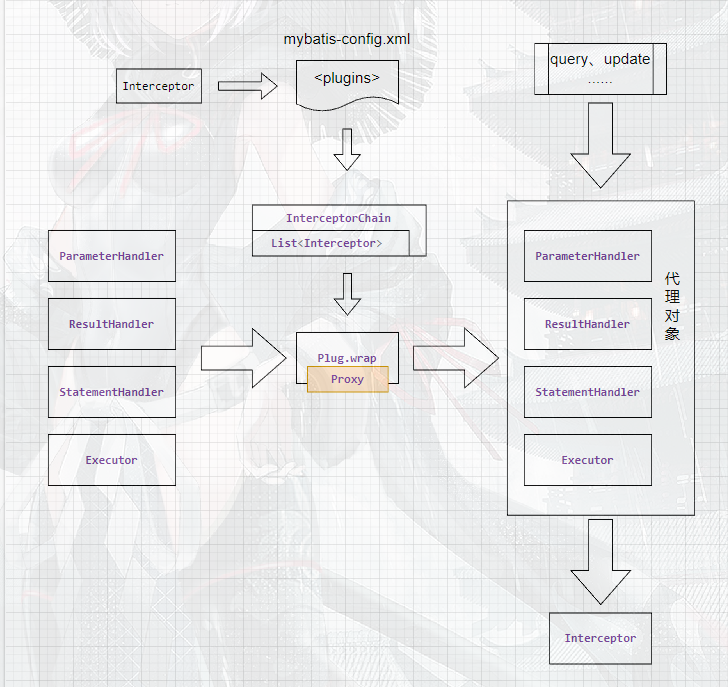mybatis插件原理
mybatis插件架构
mybatis提供插件功能,开发者可以通过注册插件的方式为mybatis增加功能。比如进行sql监控、日志记录、数据脱敏等。
mybais中插件的架构,如下图:

实现一个插件的大致流程为:
- 实现
Interceptor接口,实现intercept方法,在该方法中定义插件的逻辑。 - 将插件配置到全局配置文件中。
- mybatis解析plugins节点,将插件实例化,并注册到
Configuration中。 - mybatis在执行sql时,在特定的handler或者executor生成代理对象。调用每个插件的
intercept方法。
插件的注册
在mybatis中,通过在配置全局配置文件中增加plugins节点注册插件。mybatis在解析配置时,通过pluginElement进行插件的实例化和注册。解析后的插件,会添加到Configuration的InterceptorChain interceptorChain属性中。
private void pluginElement(XNode parent) throws Exception {
if (parent != null) {
for (XNode child : parent.getChildren()) {
// note zx 加载插件,并设置插件的参数
String interceptor = child.getStringAttribute("interceptor");
Properties properties = child.getChildrenAsProperties();
Interceptor interceptorInstance = (Interceptor) resolveClass(interceptor).getDeclaredConstructor().newInstance();
interceptorInstance.setProperties(properties);
configuration.addInterceptor(interceptorInstance);
}
}
}
使用方式如下:
<plugins>
<plugin interceptor="org.apache.ibatis.builder.ExamplePlugin">
<property name="pluginProperty" value="100"/>
</plugin>
</plugins>
AlwaysMapPlugin是一个插件的示例,可以看到一个插件需要包含:
@Intercepts注解,该注解用于指定需要拦截的方法。可以添加多个@Signature注解,来实现多个方法的拦截。@Intercepts注解中包含@Signature注解,该注解用于指定需要拦截的方法。@Signature注解中包含type、method、args三个属性。这三个属性指定了拦截的类、方法、参数类型,其作用是为了确定唯一的方法。
通过调用plugin方法,我们就创建了代理对象,之后通过代理对象调用被拦截的方法,可以看到,原有的类的行为已经被修改。
class PluginTest {
@Test
void mapPluginShouldInterceptGet() {
Map map = new HashMap();
map = (Map) new AlwaysMapPlugin().plugin(map);
assertEquals("Always", map.get("Anything"));
}
@Test
void shouldNotInterceptToString() {
Map map = new HashMap();
map = (Map) new AlwaysMapPlugin().plugin(map);
assertNotEquals("Always", map.toString());
}
@Intercepts({
@Signature(type = Map.class, method = "get", args = {Object.class})})
public static class AlwaysMapPlugin implements Interceptor {
@Override
public Object intercept(Invocation invocation) {
return "Always";
}
}
}
Info
mybatis插件代理的机制,我们可以扩展用到其他的类上,如这个案例对Map类进行了代理,而无需增加其他代码。
插件的拦截的目标
mybatis中,插件的拦截目标有以下几种:
- Executor:执行器,用于执行sql语句。
- StatementHandler:用于处理sql语句。
- ParameterHandler:用于处理sql语句的参数。
- ResultSetHandler:用于处理sql语句的返回结果。
以Executor为例,在创建完成Executor对象后,会调用pluginAll方法,该方法会遍历Configuration中的interceptorChain属性,调用plugin方法,为Executor对象创建代理对象。
public Executor newExecutor(Transaction transaction, ExecutorType executorType) {
executorType = executorType == null ? defaultExecutorType : executorType;
executorType = executorType == null ? ExecutorType.SIMPLE : executorType;
Executor executor;
if (ExecutorType.BATCH == executorType) {
executor = new BatchExecutor(this, transaction);
} else if (ExecutorType.REUSE == executorType) {
executor = new ReuseExecutor(this, transaction);
} else {
executor = new SimpleExecutor(this, transaction);
}
if (cacheEnabled) {
// note zx 如果开启二级缓存,则创建CachingExcutor对象,装饰配置中的执行器
executor = new CachingExecutor(executor);
}
// note zx 插件 拦截 Executor
executor = (Executor) interceptorChain.pluginAll(executor);
return executor;
}
InterceptorChain
InterceptorChain拦截器链用于插件的注册、代理对象的创建。代理对象的创建通过pluginAll方法实现。
pluginAll方法中,将所有拦截器遍历,依次调用plugin方法,生成代理对象。每次生成的代理对象,都会作为参数传递给下一个拦截器,直到最后一个拦截器,生成最终的代理对象。
public Object pluginAll(Object target) {
// note zx 插件 增强目标对象,提供插件功能
for (Interceptor interceptor : interceptors) {
target = interceptor.plugin(target);
}
return target;
}
Interceptor是我们插件的接口,plugin生成代理对象的默认方法是调用Plugin.wrap方法,该方法会根据target的类型,生成代理对象,具体内容见下。
Plugin
Plugin类是InvocationHandler的实现,wrap方法通过jdk动态代理创建插件对象。
wrap方法需要两个参数:target为被代理的原始类,interceptor为插件实例。具体流程为:
首先调用
getSignatureMap(interceptor)获取拦截器上的注解信息:- 获取拦截器类上的
@Intercepts注解 - 解析注解中的 @Signature 配置,提取需要拦截的方法信息
- 将这些信息保存在
signatureMap中,key 是接口类,value 是需要拦截的方法集合
- 获取拦截器类上的
获取目标对象的类型和接口:
- 通过
getAllInterfaces()方法获取目标对象实现的所有接口 - 只保留在
signatureMap中配置过的接口,也就是需要被拦截的接口
- 通过
创建代理对象,如果找到了需要被代理的接口,使用 JDK 动态代理创建代理对象使用
Proxy.newProxyInstance()方法如果没有需要代理的接口,直接返回原始目标对象
public static Object wrap(Object target, Interceptor interceptor) {
// note zx 获取拦截器上的注解,提取所有代理的方法
Map<Class<?>, Set<Method>> signatureMap = getSignatureMap(interceptor);
Class<?> type = target.getClass();
Class<?>[] interfaces = getAllInterfaces(type, signatureMap);
if (interfaces.length > 0) {
// note zx jdk动态代理
return Proxy.newProxyInstance(
type.getClassLoader(),
interfaces,
// note zx 创建代理类对象,实际调用方法时使用的是该类的invoke
new Plugin(target, interceptor, signatureMap));
}
return target;
}
实现jdk动态代理的关键是重写invoke方法。在该方法中,首先判断拦截器是否拦截该方法,如果拦截,则调用拦截器的intercept方法,否则调用原始方法。
这里需要注意的是,intercept方法的参数是Invocation,该参数包含了被代理对象、方法、参数等信息。因此在我们实现插件时,可以使用这些参数。
@Override
public Object invoke(Object proxy, Method method, Object[] args) throws Throwable {
try {
Set<Method> methods = signatureMap.get(method.getDeclaringClass());
// note zx 如果拦截器注解拦截该方法
if (methods != null && methods.contains(method)) {
// note zx 实际执行时,是调用插件的intercept方法
return interceptor.intercept(new Invocation(target, method, args));
}
return method.invoke(target, args);
} catch (Exception e) {
throw ExceptionUtil.unwrapThrowable(e);
}
}
插件案例
下面是一个插件的案例,用于统计sql执行时间。
@Slf4j
@Intercepts(value = {
@Signature(type = Executor.class, method = "query", args = {MappedStatement.class, Object.class, RowBounds.class, ResultHandler.class}),
@Signature(type = Executor.class, method = "update", args = {MappedStatement.class, Object.class}),
})
public class SqlExecuteTimeInterceptor implements Interceptor {
@Override
public Object intercept(Invocation invocation) throws Throwable {
MappedStatement statement = (MappedStatement) invocation.getArgs()[0];
long startTime = System.currentTimeMillis();
try {
return invocation.proceed();
} finally {
long endTime = System.currentTimeMillis();
log.info("sql:{},执行耗时:{} ms", statement.getId(), endTime - startTime);
}
}
@Override
public Object plugin(Object o) {
return Plugin.wrap(o, this);
}
@Override
public void setProperties(Properties properties) {
}
}





